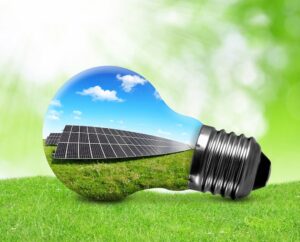 The solar future of energy is constantly evolving. First, panels themselves have become much more efficient than designs ten or 15 years ago. Homeowners can more reliably assess their needs and build out a system that promises accessible energy generation or freedom from the grid. In addition, the solar energy industry is continuously developing brand-new technologies and systems to enhance the practical applications of solar panels. In 2024, some of the biggest technologies shaping the industry are batteries and V2G systems that make the generation, storage, and distribution of electricity more dynamic. Learn more about these developing technologies and the solar future of energy, as well as localized incentive plans that make solar energy more accessible to homeowners in the area.
The solar future of energy is constantly evolving. First, panels themselves have become much more efficient than designs ten or 15 years ago. Homeowners can more reliably assess their needs and build out a system that promises accessible energy generation or freedom from the grid. In addition, the solar energy industry is continuously developing brand-new technologies and systems to enhance the practical applications of solar panels. In 2024, some of the biggest technologies shaping the industry are batteries and V2G systems that make the generation, storage, and distribution of electricity more dynamic. Learn more about these developing technologies and the solar future of energy, as well as localized incentive plans that make solar energy more accessible to homeowners in the area.
Solar panels provide an excellent avenue for free energy that can power part or all of a home. With professional installation and the right number of panels, homeowners can easily power all of their home’s appliances and systems from sunshine alone, especially in the greater Phoenix area. However, the biggest challenge many homeowners have is when the sun sets. Solar panel systems directly convert and transfer energy throughout the home, but when the panels aren’t generating electricity, the system isn’t providing energy.
This means homeowners remain partially reliant on the grid for overnight energy consumption. While net metering can reduce that cost or even neutralize it, many solar panel enthusiasts want to be entirely self-sufficient and be ready for a longer outage or completely remain off the grid.
Modern battery energy storage systems are allowing for that possibility as part of the solar future of energy. Homeowners can store batteries in their garage or attic, which holds excess energy collected during the day. Then, that stored electricity can power HVACs, televisions, and everything else the home needs. Newer batteries are increasingly safer, smaller, and more energy-efficient, making them much more useful than in previous generations.
Vehicle-to-grid (V2G) technology turns the grid from a unidirectional system into a bidirectional system. Electric vehicles, whether they’ve been powered by the grid or from a solar panel system at the owner’s home, hold a large amount of energy. During blackouts or peak energy periods, V2G systems allow homeowners to pull power from their cars. Governments are also considering the potential for a true V2G system that uses energy vehicles stored in cars to replenish power to the grid during peak usage periods. Plugged-in cars can act as batteries as demand on the grid fluctuates.
This technology is still developing, and experts in the field are still considering how to make a V2G system in local, state, and national contexts. However, homeowners themselves have access to technology that makes their electric car a backup home battery.
Solar panels are a big investment for any property, and local and state incentive programs can help offset the costs of that investment. Local homeowners can find assistance at each level of government. At the federal level, homeowners can receive a solar tax credit for the qualifying costs of new systems, as well as new panels, additional equipment, and some battery systems. In Arizona, homeowners who purchase a solar panel system may be eligible for a 25% state tax credit, and there may be additional savings for property taxes.
Phoenix, Arizona, has also established incentives for homeowners who invest in solar systems. If you install a solar energy system between now and 2032, you can receive a tax credit for up to 30% of the cost of materials and installation.
Harmon Solar is committed to equipping homes in our community with solar panels and supporting technologies. As the future of solar energy continues to evolve and make energy independence more in reach, we’ll continue to provide more education and access to our customers. Reach out today to learn more about the state of solar panels in 2024 or to schedule a consultation about making your home go solar.
Image Source: Vaclav Volrab / Shutterstock